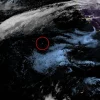HD 189733b, a planet similar in size to Jupiter, has intrigued astronomers due to its extreme weather with scorching heat, strong winds, and glass-like rain. Recently, the James Webb Space Telescope discovered hydrogen sulfide in its atmosphere, a gas that smells like rotten eggs. This is the first time this gas has been found outside our solar system, giving us new insights into the makeup of planets’ atmospheres.
Discovered in 2005, HD 189733b is classified as a “hot Jupiter” due to its close orbit around its host star, which results in very high surface temperatures. It is located just 64 light-years from Earth, making it the closest hot Jupiter that can be studied as it transits its star.
Lead study author Guangwei Fu from Johns Hopkins University highlighted the planet’s importance as a key subject for studying exoplanet atmospheric chemistry and physics, given its status as one of the first transiting exoplanets ever discovered.

The planet’s proximity to its star means it experiences extreme heat, with an average temperature of 1,700 degrees Fahrenheit (926 degrees Celsius). This intense heat generates strong winds that carry silicate particles, causing sideways glass-like rain at speeds of up to 5,000 miles per hour (8,046 kilometers per hour). These harsh conditions make HD 189733b a unique object of study, providing valuable data on the behavior of exoplanets under extreme conditions.
The Webb telescope’s capabilities allowed astronomers to detect hydrogen sulfide on HD 189733b, a molecule previously predicted to exist on gas giants but never observed outside our solar system. The detection of hydrogen sulfide, along with water, carbon dioxide, and carbon monoxide, enhances our understanding of the atmospheric composition of gas giant exoplanets.
These findings suggest that such molecules might be common on similar exoplanets, offering new insights into planetary formation and the role of sulfur as a crucial element in building complex molecules.
Further analysis of HD 189733b revealed heavy metal concentrations similar to those found on Jupiter, indicating that metal content might correlate with planetary mass and composition. This supports the theory that planets form by accumulating solid materials after their initial core formation.
The research team aims to search for sulfur signatures on other exoplanets to determine if high sulfur concentrations influence their formation and proximity to host stars. As more data from the Webb telescope becomes available, scientists hope to gain a deeper understanding of planet formation and the uniqueness of our solar system within the galaxy.

